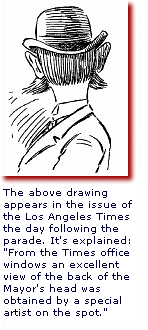Metropolitan News-Enterprise
Thursday, August 23,
2007
Page 11
REMINISCING (Column)
M & M Opens ‘Industry Hall’ During Golden Jubilee
By ROGER M. GRACE
It was on Jan. 24, 1848,
that gold was discovered in California. Fifty years later to the day, Los
Angeles celebrated its evolution within that relatively short span from a
sedentary pueblo of 1,600 persons to a major city, with established and
developing industries. The Merchants’ and Manufacturers’ Assn.—a group with
buoyant spirit that was nudging the city to develop its potential—played a
primary role in the semi-centennial festivities.
On that Monday, it
opened to the public its “Hall of Industry” featuring a display of “home
products”—that is, ones locally produced, or at least made (or grown) within
the state. A year earlier, the M & M was in the midst of staging a
well-attended six-week “Home Products Exposition” at Hazard’s Pavilion at the
northwest corner of Fifth and Olive.
But the M & M now had its own home, and a massive one, at
a downtown location south of First Street and north of Second, stretching from
Main Street on the west to Los Angeles Street. The building was owned by Max Meyberg,
prime organizer of the first Fiesta de Los Angeles in 1894, and his brother,
Moritz. They moved their retail concern, known as the Crystal Palace, to lease
the space to the M & M for its grand project.
(This was, by the way, at a time when all prominent merchants
in L.A. were white, and male…but anti-Semitism had not yet set in. Business
leaders of the Jewish faith including the Meybergs, the Newmarks, and M & M
past-president Herman Frank were part of the group—with private associations,
such as the California Club, not then discriminating.)
The M & M leased the premises for three years, starting
Jan. 1, 1898.
On Monday, Jan. 17, the M & M moved its offices from the Wilcox
Building at Second and Spring—where it had been since the merger of the
Merchants’ Assn. and the Manufacturers’ Assn. in 1896—to the Hall of Industry.
It would, however, soon be back.
On Wednesday, the Board of Directors held
its first meeting in the hall.
And on Saturday night, the hall was
dedicated in a ceremony taking place before about 2,500 invited guests.
Mayor Meredith P. Snyder, the key speaker, remarked:
“This, the opening night of a permanent
home-products exhibition in the city of Los Angeles is a most notable epoch in
the history of phenomenal progress. When the old settlers—the pioneers—stop for a moment to think of the past, they scarce believe what they see
today is real. Sometimes it seems like a dream to me, when my mind carries me back to those
days when this was a sleepy pueblo, a town of scattered adobes and a handful of
hearty, contented people. How different from today. We have a city of about one
hundred and ten thousand people, a city of handsome buildings, a city of
wealth, culture and refinement—the queen city of the great West.”
The mayor added that the exhibition would
do “incalculable good” in stimulating business. He hailed the M & M as “one
of the greatest factors in the upbuilding of the city of Los Angeles” and
which, he said, was “engaged in a noble work.”
 Doors of the Hall of Industry, on the Main Street and Los Angeles street
sides, swung open on Monday, the 24th. Crowds had lined up early that morning
to get in, and over 1,500 persons viewed the exhibition of “home products”
during the course of the day.
Doors of the Hall of Industry, on the Main Street and Los Angeles street
sides, swung open on Monday, the 24th. Crowds had lined up early that morning
to get in, and over 1,500 persons viewed the exhibition of “home products”
during the course of the day.
The hall was closed during a parade in
celebration of the opening to public, as well as 50 years since gold was struck
at Sutter’s Mill. The mayor, the members of the City Council, the members of
the Board of Supervisors, and directors of the M & M were in carriages.
Various manufacturers had
floats—including one sponsored by a soap company: a coach drawn by white horses and carrying women dressed in white.
The procession started at Sixth and Los
Angeles streets, wended it way north of the plaza, then doubled back and ended
at the Hall of Industry.
There was a free band concert at the hall
that night at 7:30.
Attendance, at first, was impressive. But
once someone had seen the displays of local goods, well, there wasn’t much of a
reason to come again.
An exhibition is not something that will
sustain interest for three years, the M & M found, shutting it down after
six months. The “Hall of Industry” became the site of a sporting goods store.
Copyright 2007, Metropolitan News Company
MetNews Main Page Reminiscing
Columns
 Doors of the Hall of Industry, on the Main Street and Los Angeles street
sides, swung open on Monday, the 24th. Crowds had lined up early that morning
to get in, and over 1,500 persons viewed the exhibition of “home products”
during the course of the day.
Doors of the Hall of Industry, on the Main Street and Los Angeles street
sides, swung open on Monday, the 24th. Crowds had lined up early that morning
to get in, and over 1,500 persons viewed the exhibition of “home products”
during the course of the day.